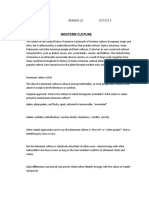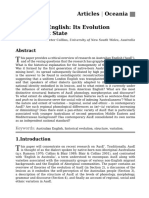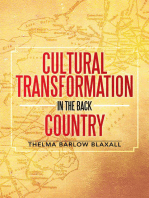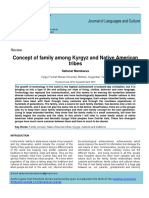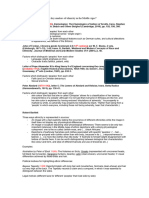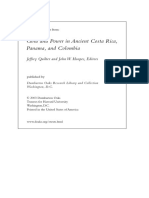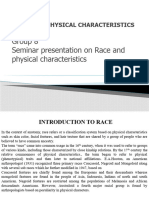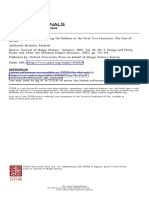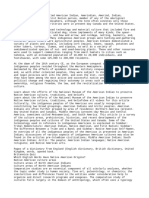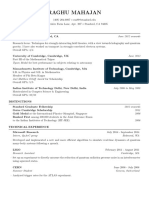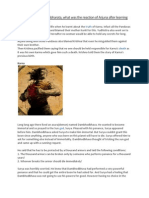Race and Ethnicity: Hair Bone
Race and Ethnicity: Hair Bone
Uploaded by
m9n8oCopyright:
Available Formats
Race and Ethnicity: Hair Bone
Race and Ethnicity: Hair Bone
Uploaded by
m9n8oOriginal Description:
Original Title
Copyright
Available Formats
Share this document
Did you find this document useful?
Is this content inappropriate?
Copyright:
Available Formats
Race and Ethnicity: Hair Bone
Race and Ethnicity: Hair Bone
Uploaded by
m9n8oCopyright:
Available Formats
RACE AND ETHNICITY
The traditional definition of race and ethnicity is related to biological and sociological
factors respectively. Race refers to a person's physical appearance, such as skin color,
eye color, hair color, bone/jaw structure etc. Ethnicity, on the other hand, relates to
cultural factors such as nationality, culture, ancestry, language and beliefs.
For example, take the Caucasian race. The physical characteristics of Caucasians were
described by M. A. MacConaill, as being "light skin and eyes, narrow noses, and thin lips.
Their hair is usually straight or wavy". Caucasoids are said to have the lowest degree of
projection of the alveolar bones which contain the teeth, a notable size prominence of the
cranium and forehead region, and a projection of the midfacial region. A person whose
appearance matches these characteristics is said to be a Caucasian. However, there are
many ethnicities within the Caucasian race e.g. Irish, Welsh, German, French, Slovak etc.
What differentiates these ethnic groups from each other is their country of origin,
language they speak, cultural heritage and traditions, beliefs and rituals.
"Race relations" is one of the dominant themes in American politics from time to time, and
refers to relationships between the major race groups - white, black, Latino and Asian. Note
that use of the word "Asian" as a race includes a vast variety of ethnicities such as Chinese,
Japanese, Korean and Vietnamese. America has also had a sometimes troubled history with
ethnic strife e.g. during the waves of Irish and Italian immigration to the U.S. These
immigrants were Caucasian but had a different ethnicity compared to the Anglo Saxons
who preceded them, and were forced to face ethnic discrimination.
You might also like
- Culture and Customs of The Sioux Indians (2011) BBS PDFDocument215 pagesCulture and Customs of The Sioux Indians (2011) BBS PDFGeorge Kwamina AnamanNo ratings yet
- 7 Language and ClassDocument38 pages7 Language and ClassGrace JeffreyNo ratings yet
- Ethnogenesis, Ethnicity, and "Cultural Refusal": The Case of The Salasacas in Highland EcuadorDocument27 pagesEthnogenesis, Ethnicity, and "Cultural Refusal": The Case of The Salasacas in Highland EcuadorMichael UzNo ratings yet
- Western Culture: Tangaro, Marcel Ann E. Bsa (Ag-2) Socsci 3Document5 pagesWestern Culture: Tangaro, Marcel Ann E. Bsa (Ag-2) Socsci 3Marcel Kenji Matsunaga TangaroNo ratings yet
- Australian English PDFDocument12 pagesAustralian English PDFNatalia RusuNo ratings yet
- Race and RacismDocument47 pagesRace and RacismNitish SehgalNo ratings yet
- BRITISH - 1-National, Regional and Local identities-LEDocument3 pagesBRITISH - 1-National, Regional and Local identities-LEMed DkouniNo ratings yet
- WEEK 5 Final Draft Doctor StricklandDocument6 pagesWEEK 5 Final Draft Doctor StricklandKimberly ThompsonNo ratings yet
- PMAL201 Self Reflection Part 1 PDFDocument8 pagesPMAL201 Self Reflection Part 1 PDFanjaliparesh52No ratings yet
- North American IndiansDocument10 pagesNorth American IndiansnellysheirNo ratings yet
- Crania AmericanaDocument2 pagesCrania Americanamurilo_favarettoNo ratings yet
- Native American Language - PrintDocument4 pagesNative American Language - PrintNita YuitaNo ratings yet
- Concept of Family Among Kyrgyz and Native American TribesDocument8 pagesConcept of Family Among Kyrgyz and Native American TribesRahatNo ratings yet
- Synthèse de L Axe 1 Unité Et PluralitéDocument3 pagesSynthèse de L Axe 1 Unité Et PluralitéTristan dspNo ratings yet
- The Lenâpé and Their Legends: With the complete text and symbols of the Walam olum, a new translation, and an inquiry into its authenticityFrom EverandThe Lenâpé and Their Legends: With the complete text and symbols of the Walam olum, a new translation, and an inquiry into its authenticityNo ratings yet
- Plains Cree IdentityDocument18 pagesPlains Cree IdentitylittlecedarNo ratings yet
- Exam Prep - Med - EthnicitiesDocument6 pagesExam Prep - Med - EthnicitiesferdmowNo ratings yet
- Designing IdentitiesDocument14 pagesDesigning IdentitieslasamdjNo ratings yet
- Uncommon Schools: The Global Rise of Postsecondary Institutions for Indigenous PeoplesFrom EverandUncommon Schools: The Global Rise of Postsecondary Institutions for Indigenous PeoplesNo ratings yet
- Language & Culture: Studying TWI in The U.SDocument2 pagesLanguage & Culture: Studying TWI in The U.SSamuel EkpoNo ratings yet
- Sociedad y CulturaDocument10 pagesSociedad y CulturannnNo ratings yet
- The Lenâpé and Their Legends: Ethnological study of the The Lenâpé Indians in Eastern PennsylvaniaFrom EverandThe Lenâpé and Their Legends: Ethnological study of the The Lenâpé Indians in Eastern PennsylvaniaNo ratings yet
- StereotypesDocument23 pagesStereotypescaironsalamNo ratings yet
- Australian CultureDocument12 pagesAustralian CultureNavjeet SandhuNo ratings yet
- Constructions of National and Cultural Identity in The Poetry of Scots MakarsDocument14 pagesConstructions of National and Cultural Identity in The Poetry of Scots MakarsdinadinicNo ratings yet
- Irish in Youngstown and the Greater Mahoning ValleyFrom EverandIrish in Youngstown and the Greater Mahoning ValleyNo ratings yet
- LANE 422 Sociolinguistics: EditionDocument18 pagesLANE 422 Sociolinguistics: EditionAfriani Indria PuspitaNo ratings yet
- Akan PeopleDocument7 pagesAkan PeopleTheMothershipNo ratings yet
- The Siouan Indians by McGee, W. J. (William John), 1853-1912Document48 pagesThe Siouan Indians by McGee, W. J. (William John), 1853-1912Gutenberg.orgNo ratings yet
- The Conquest of a Continent; or, The Expansion of Races in AmericaFrom EverandThe Conquest of a Continent; or, The Expansion of Races in AmericaNo ratings yet
- Native AmericanDocument100 pagesNative AmericanZoya RehmanNo ratings yet
- Hoopes, J Yo Fonseca2003GoldworkandChibchanidentity PDFDocument42 pagesHoopes, J Yo Fonseca2003GoldworkandChibchanidentity PDFSandra Janeth Santacruz SilvaNo ratings yet
- Highland Heritage: Scottish Americans in the American SouthFrom EverandHighland Heritage: Scottish Americans in the American SouthRating: 1 out of 5 stars1/5 (1)
- RRLFINALDocument79 pagesRRLFINALAdrienne Margaux DejorasNo ratings yet
- ENGL 1231. Native Indigenous Peoples of North AmericaDocument2 pagesENGL 1231. Native Indigenous Peoples of North Americacairn.oak18No ratings yet
- Celtic ReligionDocument23 pagesCeltic ReligionyucatanNo ratings yet
- Bridging the Gaps: Integrating Archaeology and History in Oaxaca, Mexico; A Volume in Memory of Bruce E. BylandFrom EverandBridging the Gaps: Integrating Archaeology and History in Oaxaca, Mexico; A Volume in Memory of Bruce E. BylandNo ratings yet
- Ministry of Education and Science of The Kyrgyz RepublicDocument34 pagesMinistry of Education and Science of The Kyrgyz RepublicSezim SalamatovaNo ratings yet
- Seminar ArmzyDocument11 pagesSeminar ArmzyInnocentNo ratings yet
- Table of Contents:: DNA Tribes Digest November 1, 2011Document14 pagesTable of Contents:: DNA Tribes Digest November 1, 2011komooryNo ratings yet
- Native American Wisdom: A Spiritual Tradition at One with NatureFrom EverandNative American Wisdom: A Spiritual Tradition at One with NatureRating: 4 out of 5 stars4/5 (1)
- The Balkan Vlachs-AromaniansDocument12 pagesThe Balkan Vlachs-Aromaniansvaler_crushuveanlu100% (1)
- Designing Identities Reshaping The Balkans in The First Two Centuries - The Case of Serbia - Bratislav PantelićDocument15 pagesDesigning Identities Reshaping The Balkans in The First Two Centuries - The Case of Serbia - Bratislav PantelićZehra ŠkrijeljNo ratings yet
- The Celts and The Native AmericansDocument16 pagesThe Celts and The Native Americanselia.1xhaniNo ratings yet
- Please Try To Overcome Your Mistakes To Earn More MarksDocument1 pagePlease Try To Overcome Your Mistakes To Earn More MarksHamna Baloch BalochNo ratings yet
- Cahpter 1 The AustronesiansDocument17 pagesCahpter 1 The AustronesiansKristine Abby MainarNo ratings yet
- Kramsch - Language and Cultural IdentityDocument16 pagesKramsch - Language and Cultural IdentityprofessoranaalvesNo ratings yet
- Aboriginals People and European Settlers' ColonisationDocument10 pagesAboriginals People and European Settlers' ColonisationSeema DasNo ratings yet
- Native American, Also Called AmericDocument2 pagesNative American, Also Called Americtamilore.timikNo ratings yet
- Ethnic Groups of North or Central AsiaDocument40 pagesEthnic Groups of North or Central AsiaGabrielDF29No ratings yet
- 7411-Article Text-17713-1-10-20121210 PDFDocument20 pages7411-Article Text-17713-1-10-20121210 PDFflmcrpNo ratings yet
- Merits and Demerits of Mixed EconomyDocument7 pagesMerits and Demerits of Mixed Economym9n8oNo ratings yet
- Book List FinalDocument2 pagesBook List Finalm9n8oNo ratings yet
- CVDocument2 pagesCVm9n8oNo ratings yet
- How To Prepare Polity For IASDocument2 pagesHow To Prepare Polity For IASm9n8oNo ratings yet
- MahabharataDocument3 pagesMahabharatam9n8oNo ratings yet
- AbelsProof Peter PesicDocument222 pagesAbelsProof Peter Pesicm9n8oNo ratings yet



